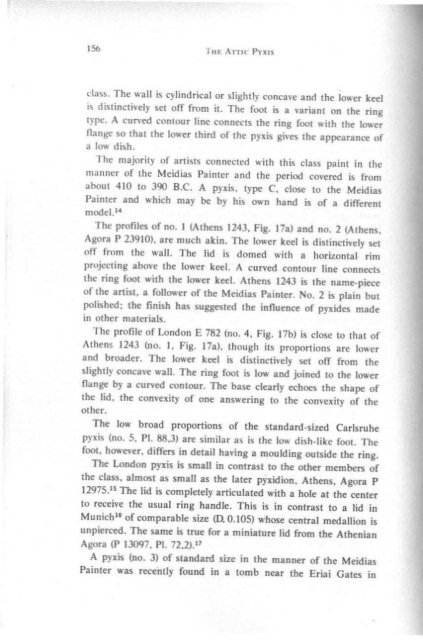Create successful ePaper yourself
Turn your PDF publications into a flip-book with our unique Google optimized e-Paper software.
\5<br />
\57<br />
da$S. The wall is cylindrical or slightly conca\'c and the lower keel<br />
I~ dislincth'ely set ofT from it. The fOOl is a variant OD the ring<br />
IYpe· A cun'M contour line connects the ring (001 with Ihe lowu<br />
nunge so that the lo.....er third of the pyz"is gh'es the appearance of<br />
a lo~ dish.<br />
The majority of artists connected with this class paint in the<br />
munner of the Mcidias Painter and the period covered is from<br />
about 410 to 390 D.e. A pyxis. type C. dose to lhe Meidias<br />
Painter and .... hich nlay be: by his own hand is of a different<br />
mode!.l.<br />
The profiles of no. I (Athens 1243. Fig. 17.) and no. 2 (Athens.<br />
Agara P 23910). afC much akin. The lower keel is distinctively set<br />
off from the wall. The lid is domed wilh a horizontal rim<br />
projecting above Ihe IOlA"er keel. A curved contour line connects<br />
the ring foot with the JaYo'er keel. Athens 1243 is the name-ptece<br />
of the artist. a follO\\er of the Meidias Painter. No. 2 is plain but<br />
polished: the finish has suggested the influence of pyxKles made<br />
in other materials.<br />
The profile of london E 782 (no. 4. Fig. 17b) is close 10 that of<br />
Athens 1243 (no. l. Fig. 17a). though iu proportions are lower<br />
and broader. The lower keel is distinctively set ofT from the<br />
slightly concne wall. The ring foot is 10\\ and joined to the ~wer<br />
fl"nge by a curved contour. The base clearly echoes the shape of<br />
the lid. the conveJ:ity of one answering to the conH:J:ity of the<br />
other.<br />
The low broad proportions of the standard-sized Carlsruhe<br />
pyxis (no. 5. PI. 88.3) are similar as is the low dish·like foot. The<br />
fOOl, however. differs in detail having a moukting OUtside the ring.<br />
The London pyxis is small in contrast to the other members of<br />
the class. almost as small as the later pyxtdion. Athens. Agora P<br />
12975. 15 The lid is completely articulated with a hole at the center<br />
to receive the usual ring handle. This is in contrast to a lid in<br />
Munich ll of comparable size ID. 0.105) whose central medallion is<br />
unpierced. The same is true for a miniature lid from the Athenian<br />
Agora (P 13097. PI. 72,2).u<br />
A pyxis (no. 3) of standard size in the manner of the Meidias<br />
Painter was recently found in a tomb near the Eriai Gates in<br />
Athens. It appears to conform to the characteristics of the class<br />
and 10 be quite sinlilar to London E 782. It has a ring foot joined<br />
by a cuned contour to the !ovt'er keel as is usual in this class. It has<br />
the ordinary egg and dot pattern ca the rim and I~er flange. Like<br />
London E 782 (no. 4,Pt. 88.2). the wall is embellished with a mynle<br />
wreath.<br />
The angle from which the photograph of the pyxis in Dresden<br />
(no. 6. PI. 89.3) has been taken, emphasized the foot while<br />
di!iltorting the shape of the profile. The ring foot is connected by a<br />
cun·«J contour line to the outer rather than the inner edge of the<br />
lower keel in contrast to no. I (Fig. 17a) and no. 2.<br />
London E 776 (no. 7. PI. 90.1) in its measurements and<br />
proportions comes very close to the pyxis in Dresden. It conforms<br />
to the characteristics of the class in its main features. The wall is<br />
!illightly concav~ and the lower keel is distinctly set off from it.<br />
The 10.... ring foot is connected to the Iowet'" keel by a curved<br />
contour. The profiling of the lid. however, is very individual. The<br />
lid is domed .....ith two lightly raised rings around the center<br />
bordering the pattern band. This is quite usual. but the double<br />
curved moulding setting off the rim from the main convex surface<br />
and the double curved profile of the side of the lid are<br />
refinements unparalleled in the class. The artist in additton is an<br />
outsider. not a member of the Meidian circle. The pyxis is<br />
unatlr;butcd.<br />
No. 10 [Toronto 370, PI. 89.1). has a domed lid some.... hat<br />
naUened in contour. The wall is slightly concave with a sloping<br />
lo.....er keel distinctly offset by a double ridge. There is a simple<br />
ring foot. at variance with the usuaJ foot type of the class.<br />
The rim and lower flange: are omamented by an inverted egg<br />
and dot pattem. This is a favorite pattern formula also found on<br />
Athens 1243 (no. I), Dresden 385 (no. 6), a lid in Heidelberg ll in<br />
the manner of the Meidias Painter. and a fragmentary lid Athens,<br />
Agora P 98.n This inversion of the usual egg pattern may also<br />
sometimes be obsen'ed on lebetes gamikoi and loutrophoroi.<br />
The profile of Wurzburg 543 (no. 11) is very close to that of the<br />
pyxis in Toronto. The wall is concave with a 100000-er flange<br />
distinctly offset by a ridge. The Hd is of a flattened domed

















